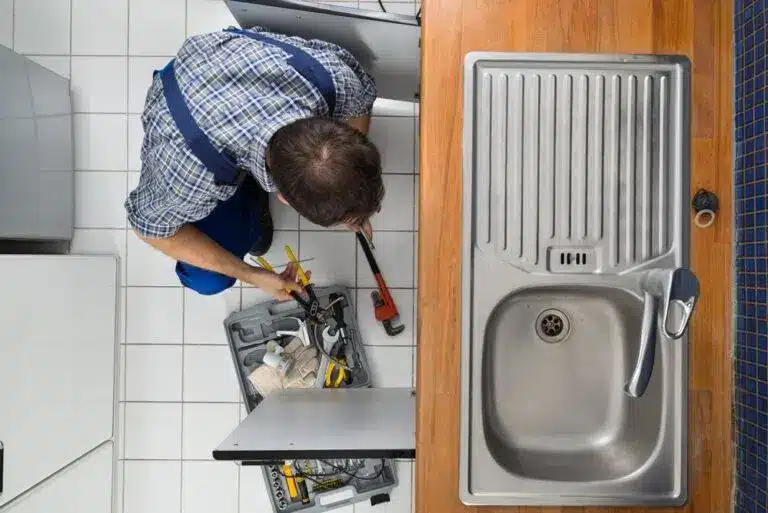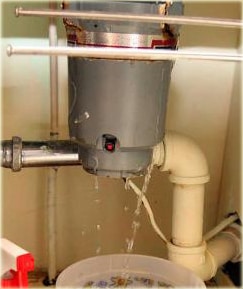Step-by-Step Techniques for Repairing a Leaky Garbage Disposal
Step-by-Step Techniques for Repairing a Leaky Garbage Disposal
Blog Article
Are you currently trying to locate facts on Garbage Disposal Leaking From Bottom?

Waste disposal unit are vital cooking area appliances that help in throwing away food waste efficiently. Nonetheless, a dripping waste disposal unit can be a discouraging and unpleasant issue to manage. Luckily, numerous leaks can be repaired conveniently with a few basic steps. In this post, we will certainly review just how to take care of a leaking garbage disposal successfully.
Introduction
Waste disposal unit are set up under kitchen sinks and are made to shred food waste right into smaller pieces, permitting it to pass through the plumbing system easily. While these gadgets are normally trustworthy, leaks can take place with time due to wear and tear, loosened connections, or damages to the device.
Usual Causes of Leaks in Rubbish Disposals
Worn Seals and Gaskets
Seals and gaskets play a vital duty in protecting against water from leaking out of the garbage disposal. Gradually, these components can weaken, causing leakages around the disposal system.
Loose Links
The connections in between the garbage disposal and the plumbing system can become loose gradually, causing water to leakage out during operation.
Cracks or Openings in the Disposal Unit
Physical damage to the waste disposal unit, such as splits or openings in the housing, can also cause leakages.
Recognizing the Source of the Leakage
Prior to attempting to repair a dripping garbage disposal, it is necessary to recognize the resource of the leak. This can usually be done via visual assessment or by conducting simple tests.
Visual Evaluation
Evaluate the garbage disposal device carefully for any type of indicators of water leak. Pay very close attention to locations around seals, gaskets, and connection points.
Evaluating for Leaks
One way to examine for leaks is by running water with the disposal device and looking for any type of visible signs of leakage.
Tools and Materials Needed for Dealing With a Leaking Waste Disposal Unit
Before starting the fixing process, collect the required tools and materials, including a screwdriver, flexible wrench, plumbing technician's putty, substitute seals or gaskets, and epoxy or patching read more material for fixing fractures or holes.
Step-by-Step Overview to Taking Care Of a Leaking Garbage Disposal
Turn Off the Power
Before attempting any kind of repair work, make certain that the power to the waste disposal unit unit is turned off to stop the risk of electric shock.
Situate the Leakage
Determine the exact area of the leakage and establish the reason.
Tighten Connections
Make use of a wrench to tighten up any kind of loose links in between the disposal unit and the plumbing system.
Replace Seals or Gaskets
If the leak results from worn seals or gaskets, get rid of the old parts and change them with new ones.
Patching Splits or Openings
For cracks or openings in the disposal unit, usage epoxy or a suitable patching material to secure the damaged location.
Testing the Waste Disposal Unit After Repair Service
As soon as the repair work is total, evaluate the garbage disposal by running water via it to make sure that the leak has actually been dealt with.
Preventive Maintenance Tips to Prevent Future Leakages
To prevent future leakages, it is essential to do routine upkeep on your waste disposal unit. This consists of maintaining it clean, avoiding putting non-food items or difficult items down the disposal, and periodically looking for leakages or other problems.
Verdict
Finally, repairing a dripping garbage disposal is a fairly simple procedure that can be completed with basic devices and products. By following the actions described in this short article and practicing precautionary upkeep, you can maintain your garbage disposal in good working problem and stay clear of expensive fixings in the future.
HERE’S HOW TO FIX YOUR GARBAGE DISPOSAL
WHAT TO DO IF SOMETHING IS STUCK IN YOUR GARBAGE DISPOSAL
If the impeller won’t turn, there’s probably something stuck in the disposal. It could be a steak bone or peach pit, although plumbers report pulling all sorts of inappropriate objects out of disposals, such as bottle caps or aluminum foil. Make sure power to the disposal is off, and look inside to see if you can see the source of the jam.
Never stick your fingers in a disposal. Pull out anything you see with tongs or pliers.
If the disposal still won’t work, it may be time to call a plumber or consider buying a new disposal. GEM Plumbing & Heating is here for all of your garbage disposal needs.
WHAT TO DO IF YOUR GARBAGE DISPOSAL DRAIN IS CLOGGED
Take everything out from underneath your sink and put a bucket or other container under your disposal to catch any water that drains out. Disconnect your disposal from the power supply. If it’s plugged into a wall outlet, unplug it. If it’s hardwired into an electrical box, go to the electrical panel and turn off the breaker for the disposal. Pour ¼ cup of baking soda into the drain, followed by ½ cup of white vinegar. Give the solution a few minutes to fizz and do its work. Look into the disposal with a flashlight to see if you can see an object that might be causing the clog. If you see it, remove it using tongs or pliers. MORE TIPS ON DEALING WITH A CLOGGED GARBAGE DISPOSAL
Never use drain cleaner in a garbage disposal. It can damage the plastic parts inside the disposal. You can also be splashed with the caustic liquid while working to clear the clog. Beware! Never stick your fingers into a garbage disposal. Trust us — not a good idea. In many instances, your dishwasher drains through your garbage disposal. This allows the disposal to grind any large food particles that may be drained out of your dishwasher. There are some jurisdictions, however, where the plumbing code prohibits such a connection. WHAT TO DO WHEN YOUR DISHWASHER DRAINS THROUGH THE DISPOSAL
Run some water in the sink so your plunger has at least a ½-inch of water to create a seal and plunge vigorously up and down several times. You may need to repeat this several times. Run hot water down the drain to clear any residue that remains.

We are very inquisitive about Why Is and I'm hoping you enjoyed my piece. If you enjoyed reading our page if you please remember to share it. Thanks for taking the time to read it.
Learn More Report this page